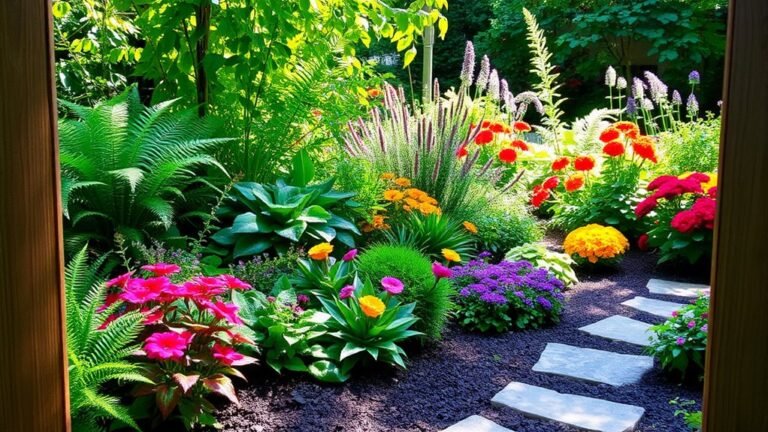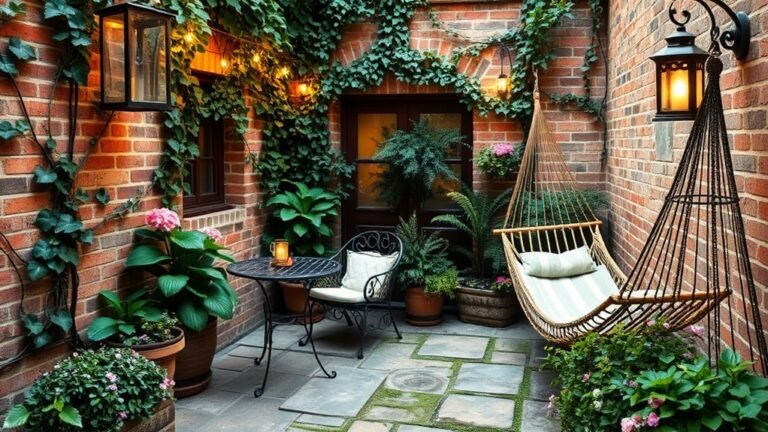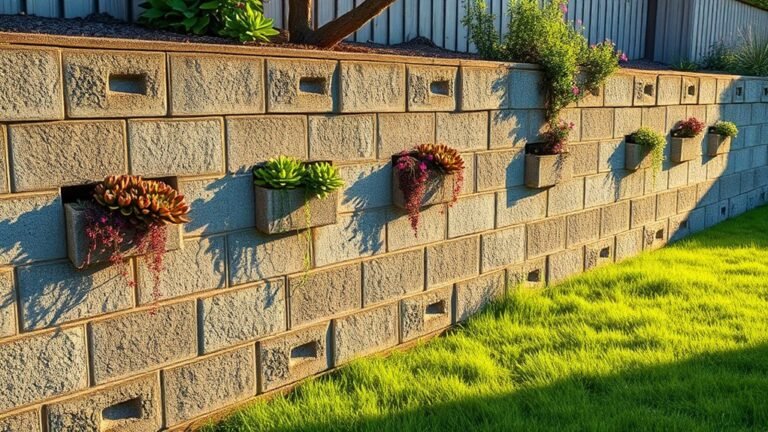13 Small Backyard Vegetable Garden Ideas
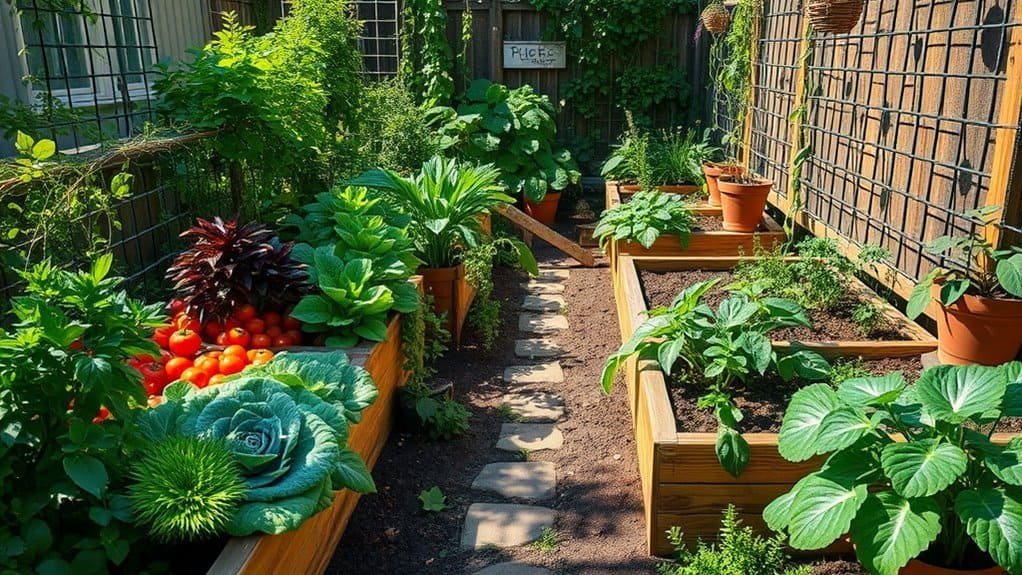
Transform your small backyard into a flourishing vegetable garden with innovative ideas that maximize space. Limitations can lead to creative solutions like vertical gardening and container options for fresh produce.
Explore various methods to turn your limited area into a productive oasis, each offering unique benefits. Discover the secrets to unlocking your garden's full potential.
Vertical Gardening Techniques
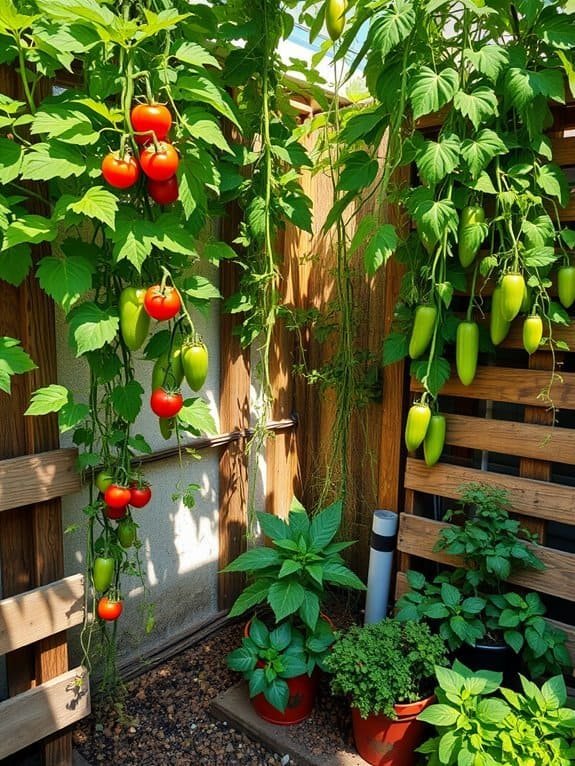
If you're short on space but eager to grow vegetables, vertical gardening techniques can be transformative. You can easily access fresh tomatoes or crisp cucumbers without maneuvering through dense foliage. By encouraging plants to grow upwards, vertical gardening maximizes your garden area.
Utilize trellises, wall planters, or repurpose old pallets to create an eye-catching vertical garden—think of your veggies living in a skyscraper! With creativity, you can design a lush green wall that enhances your backyard's beauty while conserving space.
Climbing plants like peas, beans, and cucumbers thrive in this setup and will reward you with a bountiful harvest. Ensure your vertical garden receives sufficient sunlight for optimal plant growth, and be prepared for a bit of tricky watering.
With patience and enjoyment, you can soon relish the fruits (and veggies) of your labor, all while maintaining an organized and stylish garden!
Container Gardening Options

Container gardening is a flexible and convenient way to grow vegetables, perfect for those with limited space. You don't need a large yard to enjoy fresh produce—just a few pots and some soil will do.
Whether you have a sunny balcony, a small patio, or a windowsill, you can create a veggie paradise!
Select containers that match your style—colorful pots, rustic wooden boxes, or even recycled items like buckets—ensuring they've drainage holes.
Herbs like basil and parsley thrive in smaller pots, while larger vegetables like tomatoes and peppers need bigger containers.
Incorporate good potting soil and a bit of fertilizer to keep plants thriving.
Remember, container plants dry out faster than ground-planted ones, so regular watering is essential.
Container gardening isn't only practical but also enjoyable!
Experiment with different plants, create beautiful arrangements, and easily move containers to optimize sunlight.
Grab your pots, get your hands dirty, and let's grow some delicious veggies together!
Raised Bed Gardens
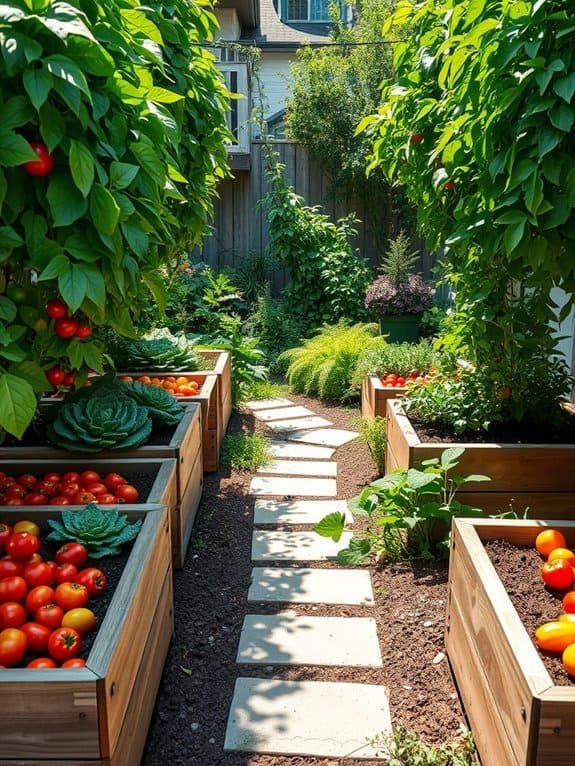
Raised bed gardens efficiently cultivate vegetables by maximizing space and improving soil conditions, making them ideal for small backyards. You can easily customize their height and size to suit your needs.
One of the advantages of raised beds is the control you have over the soil, ensuring your plants receive the necessary nutrients. They also drain better than traditional gardens, preventing waterlogging during heavy rains.
Maintaining your plants and weeding is easier, giving you more time to enjoy your garden. Raised beds are also beneficial for those with limited mobility.
Enhance your garden's appeal by adding flowers or companion plants to attract beneficial insects.
Get ready to dig in and create your vegetable paradise right in your backyard!
Herb Spiral Garden
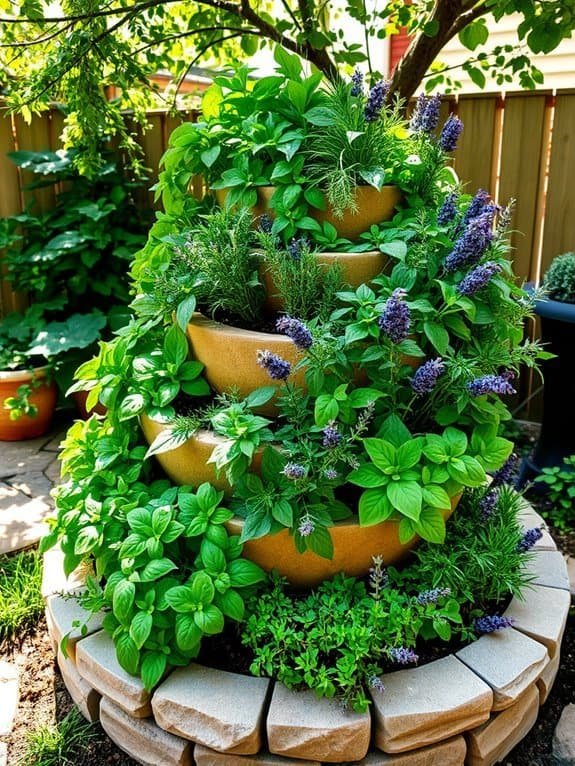
An herb spiral garden is an innovative way to grow various herbs in a compact space.
This spiral structure not only enhances aesthetics but also optimizes gardening potential by creating different microclimates.
The bottom can host moisture-loving herbs like mint and basil, while drought-tolerant varieties such as rosemary and thyme thrive at the top.
The design allows easy access to each herb without stepping into the garden, protecting your plants from accidental damage.
You can save space and even incorporate flowers or edible plants.
Picture making fresh pesto with basil from your spiral!
It's also a charming conversation starter.
Start building your herb spiral; your gardening dreams are just a twist away!
Square Foot Gardening
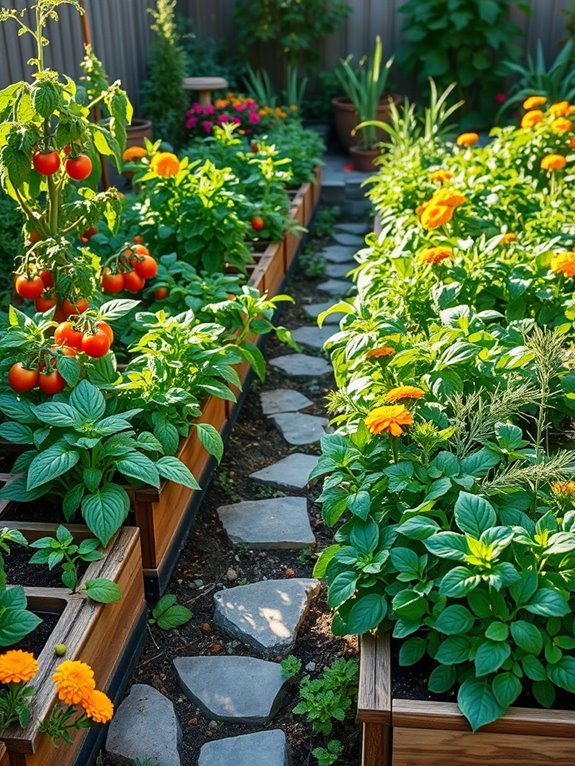
If you want to maximize your gardening space, square foot gardening is an efficient method. This technique enables you to grow a variety of vegetables in a small area, ideal for your cozy backyard. By creating a grid layout in raised beds divided into one-foot squares, each can host different plants, allowing you to enjoy a mini salad bar at home!
Here's a quick reference table to get started:
| Square Foot | Recommended Plant |
|---|---|
| 1 | Lettuce |
| 2 | Radishes |
| 3 | Carrots |
| 4 | Bush Beans |
| 5 | Spinach |
Imagine harvesting fresh veggies from your garden without dealing with lengthy rows! You can mix and match based on your preferences and easily track your plants. So grab your trowel and let's get those square feet growing!
Window Box Vegetable Garden
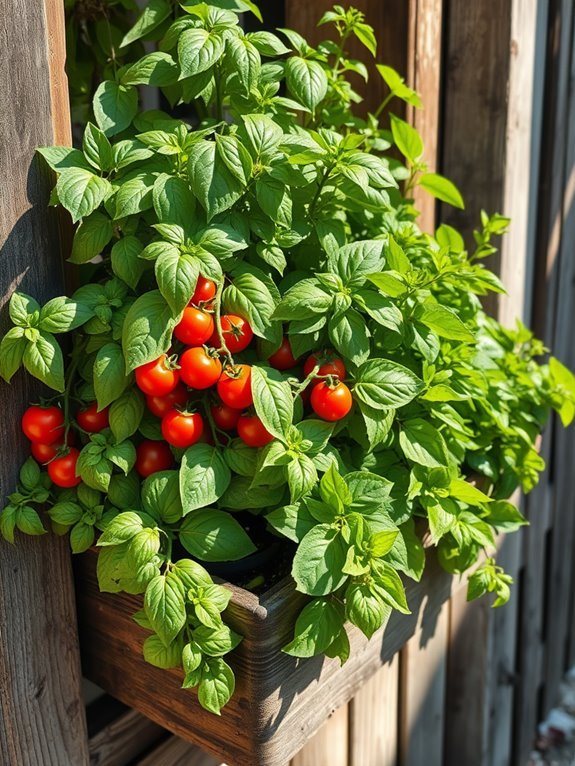
Want to enjoy fresh vegetables in limited space? A window box vegetable garden is the ideal solution! These delightful gardens can turn any window sill into a vibrant green oasis, perfect for small areas.
Start by selecting a sunny spot, as most veggies need at least six hours of sunlight daily. Choose your favorite plants—basil, parsley, cherry tomatoes, and radishes thrive well!
Opt for a sturdy window box at least 6-12 inches deep to allow roots to flourish. Ensure proper drainage by using a box with holes or adding pebbles at the bottom. Fill with quality potting soil and you're ready to plant!
Water regularly, keeping in mind to provide a revitalizing drink, not a flood. With a little care, you'll enjoy fresh veggies and impress friends with your gardening skills—all while bringing a bit of nature indoors!
Pallet Garden Ideas
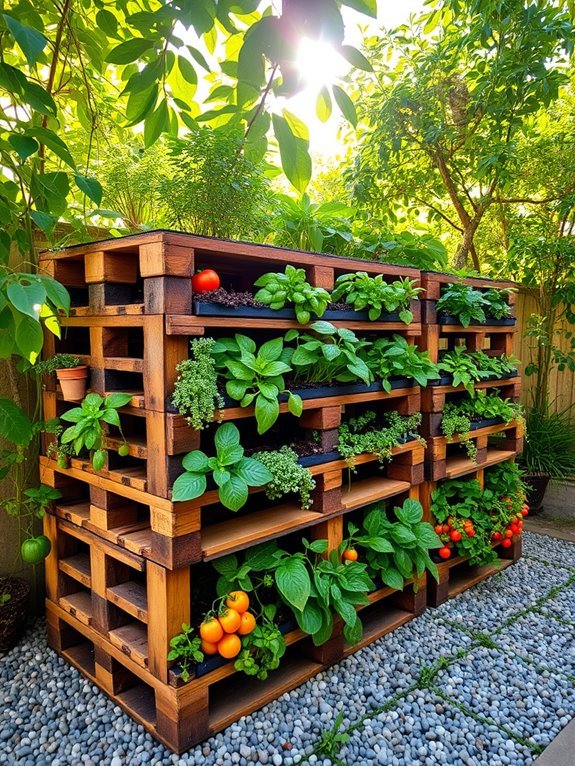
Pallet gardens are a stylish and innovative solution for maximizing gardening potential in small spaces.
You can easily turn an old wooden pallet into a vertical garden that enhances your backyard. Simply lay the pallet flat, fill it with soil, and plant herbs or vegetables like basil, lettuce, and strawberries.
For an upright design, position the pallet vertically against a wall or fence, ensuring it's securely reinforced to prevent it from tipping over.
These gardens allow you to repurpose materials, contributing to an eco-friendly and trendy look.
They're low-maintenance—just water regularly and enjoy the process, which provides the bonus of light exercise as you tend to your plants.
Straw Bale Gardening

Straw bale gardening is a simple and effective method, perfect for small spaces or poor soil. You can grow vegetables on straw bales with no tilling necessary—just set them up in your backyard!
Here are the key benefits of straw bale gardening:
| Benefit | Description | Why You'll Love It |
|---|---|---|
| Easy Setup | Place bales in a sunny spot. | No digging or heavy lifting! |
| Good Drainage | Bales drain well and warm quickly. | Your plants will thrive! |
| Pest Management | Bales can naturally deter pests. | Fewer bugs, more veggies! |
| Creative Shapes | Arrange bales into any design. | Personalize your garden! |
Begin by conditioning the bales with water and fertilizer, then plant seeds or seedlings directly into them. Enjoy this fun gardening style and watch your plants flourish! Grab some straw bales, and start your gardening adventure!
Hydroponic Systems

To enhance your gardening, consider hydroponic systems that eliminate soil entirely. You can grow vibrant vegetables in your backyard, making it an innovative way to garden.
Picture plants thriving in nutrient-rich water, growing faster and healthier than those in soil.
Here are three key components for your hydroponic setup:
- Growing Medium: Use materials like coconut coir or perlite to support plants while ensuring good drainage.
- Nutrient Solution: Provide a balanced nutrient solution to nourish your plants—think of it as their gourmet meal!
- Watering System: Choose between drip irrigation or nutrient film technique to keep your plants hydrated and happy without the mess of traditional gardening.
Succession Planting
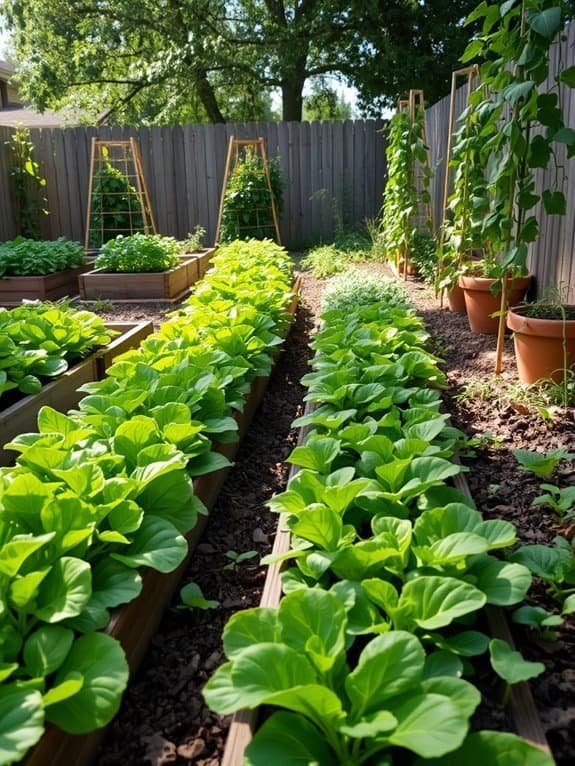
Hydroponic systems provide an innovative method for growing vegetables, and succession planting can enhance your garden's productivity even further.
Imagine enjoying fresh greens every few weeks rather than just once or twice a season—that's the beauty of succession planting! By staggering your plantings, you can savor a continuous harvest throughout the growing season.
Start with quick-growing crops like radishes and lettuce. After harvesting, replant the same spot with slower-growing varieties such as carrots or beets to avoid empty soil.
Timing is crucial; planting every couple of weeks keeps your garden vibrant.
Love a particular vegetable? Plant it in cycles for a steady supply without overwhelming yourself during harvest.
This approach keeps the excitement alive, offering a continuous array of fresh veggies – like a personal gardening buffet.
Edible Landscaping
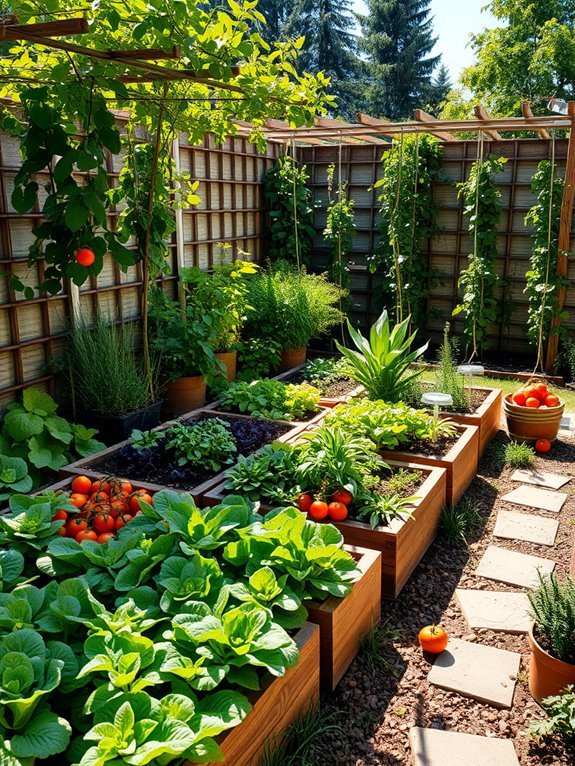
Transform your backyard into an edible landscape that not only beautifies your space but also provides fresh produce at your fingertips.
Imagine picking a handful of cherry tomatoes or snipping fresh herbs for dinner—your own grocery store, without the lines!
Here are three fun ways to start edible landscaping:
- Mix it Up: Pair flowers with vegetables, like marigolds next to zucchini or lavender with strawberries. This adds color and attracts pollinators.
- Vertical Gardens: Short on space? Consider vertical gardening with wall-mounted planters or trellises for climbing plants such as peas or beans, adding height and maximizing your area.
- Colorful Edibles: Grow rainbow chard, purple carrots, or red kale for both taste and a splash of color in your garden.
Get creative and enjoy transforming your backyard into a delicious haven!
Your taste buds (and your neighbors) will thank you.
Community Garden Participation

Joining a community garden can enhance your backyard gardening experience. You'll not only grow fresh produce but also connect with fellow gardening enthusiasts. Picture the joy of sharing tips, swapping seeds, and tasting prized tomatoes!
Here are some key benefits of community gardens:
| Benefits | Details |
|---|---|
| Social Connections | Meet fellow gardeners and build friendships. |
| Shared Resources | Utilize tools and expertise you may lack. |
| Learning Opportunities | Participate in workshops to improve your skills. |
| Fresh Produce | Savor a variety of fruits and vegetables. |
| Sense of Community | Contribute to a shared goal and enhance the environment. |
Community gardens frequently organize fun events such as potlucks and harvest festivals, making it a wonderful opportunity to involve your children in gardening. They'll learn valuable lessons and create lasting memories. If you're eager to broaden your gardening experience and meet amazing people, consider joining a community garden—you'll be glad you did!
Indoor Vegetable Gardening

Indoor vegetable gardening is a fantastic way to enjoy fresh produce year-round. Imagine harvesting ripe tomatoes or crisp lettuce from your kitchen, regardless of the season!
It's more accessible than you think, and you don't need extensive gardening skills to begin.
Here are three essential tips to start your indoor garden:
- Choose a Sunny Spot: Locate a bright windowsill or well-lit area, as most vegetables require at least six hours of sunlight daily.
- Select Easy Plants: Begin with beginner-friendly options like herbs (basil, parsley) or leafy greens (spinach, lettuce), which thrive indoors and enhance your meals while needing minimal space.
- Water Carefully: Monitor soil moisture and water when the top inch feels dry. Be cautious not to overwater, as soggy roots can harm your plants.
With some effort, your indoor garden can bloom, adding greenery and flavor to your home.
Happy gardening!
Frequently Asked Questions
What Vegetables Grow Best in Shady Backyard Areas?
If you've got a shady backyard, don't fret! Some veggies love the low light.
Try growing leafy greens like spinach and lettuce; they'll thrive in those cooler spots. Radishes and beets also enjoy the shade, plus they're super easy to grow.
If you're feeling adventurous, consider broccoli or kale; they'll add a tasty crunch to your meals.
How Can I Improve Soil Quality for My Vegetable Garden?
Think of your soil as the foundation of a house; it needs to be solid for everything to thrive.
To improve soil quality, start by adding organic matter like compost or aged manure. This boosts nutrients and improves drainage.
A soil test can guide your amendments, ensuring you're not flying blind.
Don't forget to rotate your crops yearly!
Healthy soil leads to happy plants, and who doesn't want a thriving garden?
Happy gardening!
What Pests Should I Watch for in Small Gardens?
When you're tending to your garden, watch out for pesky pests like aphids, snails, and spider mites. They love munching on your plants, and trust me, they can be sneaky!
Keep an eye out for holes in leaves or sticky residue; that's a sure sign of trouble. You might even spot some cute ladybugs — they're your allies, munching away on those bad bugs.
How Often Should I Water My Vegetable Plants?
Water your vegetable plants regularly, usually about once a week, but keep an eye on the soil.
If it feels dry a couple of inches down, it's time to give them a drink. Picture your plants gulping down that cool water, soaking in the sun's warmth, and thriving!
If it rains, you can skip watering. Just remember, too much water can drown them, so strike a balance, and your veggies will flourish!
What Is the Best Time to Plant Vegetables in My Region?
You're probably itching to get those veggies in the ground!
The best time to plant depends on your region, but generally, wait until the last frost date. For most places, that's in late spring.
You can start seeds indoors a few weeks before then to get a jump on the season. Just think of it as giving your plants a cozy little head start!
Who knew gardening could be so much fun?
Conclusion
Whether you're stacking your greens vertically or planting herbs in spirals, your small backyard can flourish as a veggie haven! Gardening has been shown to reduce stress levels by up to 36%, making it great for mental health.
So grab your trowel and get your hands dirty. Enjoy the fruits (and veggies) of your labor, and may your harvests be bountiful and delicious! Happy gardening!



